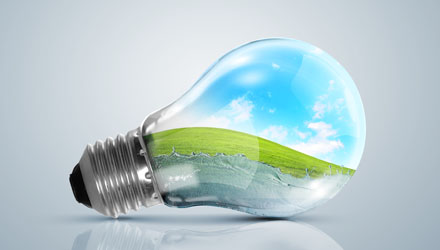Eco-design is a preventive measure that makes it possible to create new products that are more environmentally friendly than in previous generations. Ever more companies are adopting these measures, which give a sustainable development dimension to their activities.

The environmental impact of products is an increasing source of concern in contemporary society. Eco-design has thus become an essential element in all sectors of industry. This preventive approach consists of taking environmental criteria into account from the design and product improvement phases alongside conventional criteria such as cost, quality, technical feasibility and market expectations. The aim of the approach is to reduce environmental impact as much as possible: climate change; material and energy consumption; water, air and soil pollution; waste production; noise; etc. The solutions being offered to society and manufacturers therefore include markedly improved environmental performance together with a much lower environmental footprint whilst maintaining the same - or better - levels of technical performance with costs adapted to the market.
A cross-cutting discipline
Not only do we need to reduce environmental impacts, but we must also avoid or mediate the transfer of pollution and ensure that the behaviour of the entire chain of relevant stakeholders at every stage of the cycle contributes to the aim of protecting the environment*, states Daniel Brissaud, professor at Grenoble INP - Industrial Engineering and researcher at the G-SCOP laboratory. In concrete terms, various strategies are possible that may or may not be combined, such as material substitution; reducing electricity consumption whilst the product is in use; increasing the potential for end-of-life recycling; simplifying the sub-contractor chain; and the partial elimination of packaging.
Eco-design is, therefore, very much a multi-disciplinary science by nature. Although there is no standard' methodology for quantifying to what degree a product has been eco-designed, some companies are developing their own evaluation tools. The discipline is so cross-cutting that it must be taught on all the engineering courses because the issues are found in all areas of the profession, explains Hélène Bortoli from the French Environment and Energy Management Agency (ADEME). Accordingly, eco-design teaching is currently scattered across different courses and options at Grenoble INP. However, two years ago the School of Industrial Engineering recruited a professor to create a specific training programme. With the engineering students in their first year, we work on basic tools for assessing the environmental impact of products in collaboration with the eco-design space situated on the premises of the Fab-Lab GI-Nova, states Peggy Zwolinski, professor in Industrial engineering and researcher at the G-SCOP laboratory. This work can be completed in the second year or they can study the levers for designing cleaner products and production systems, including via the regulatory aspects. In the third year, we offer several optional modules for examining industrial organisations and the incentive mechanisms for helping companies to incorporate eco-design into their systems and practices.
As for Pagora, it offers third-year engineering students the possibility of following the Industrial Processes and Environmental Management (PIME) semester, which furthers their understanding of the natural environment and helps to develop strong skills in environmental management and assessing environmental impact.
Finally, a great deal of research work is being carried out in the group's laboratories. Peggy Zwolinski, who is also a researcher at G-SCOP, studies, in various ANR and European projects (and in collaboration with manufacturers from different sectors), the design office tools that help to predict energy consumption during usage as well as tools for qualifying the potential for re-use at the end of use; managing the development of new technologies; simulating the environmental behaviour of complex systems; and calculating the environmental impact in particular sectors. She also studies the tools and methods for jointly designing products and services in innovative solutions.
* This consists of systematically questioning what happens when environmental impact is transferred: What is preferable - a solution that consumes less material but is more polluting? A solution that uses machines that pollute less but that increases the number of HGVs on our roads?

The environmental impact of products is an increasing source of concern in contemporary society. Eco-design has thus become an essential element in all sectors of industry. This preventive approach consists of taking environmental criteria into account from the design and product improvement phases alongside conventional criteria such as cost, quality, technical feasibility and market expectations. The aim of the approach is to reduce environmental impact as much as possible: climate change; material and energy consumption; water, air and soil pollution; waste production; noise; etc. The solutions being offered to society and manufacturers therefore include markedly improved environmental performance together with a much lower environmental footprint whilst maintaining the same - or better - levels of technical performance with costs adapted to the market.
A cross-cutting discipline
Not only do we need to reduce environmental impacts, but we must also avoid or mediate the transfer of pollution and ensure that the behaviour of the entire chain of relevant stakeholders at every stage of the cycle contributes to the aim of protecting the environment*, states Daniel Brissaud, professor at Grenoble INP - Industrial Engineering and researcher at the G-SCOP laboratory. In concrete terms, various strategies are possible that may or may not be combined, such as material substitution; reducing electricity consumption whilst the product is in use; increasing the potential for end-of-life recycling; simplifying the sub-contractor chain; and the partial elimination of packaging.
Eco-design is, therefore, very much a multi-disciplinary science by nature. Although there is no standard' methodology for quantifying to what degree a product has been eco-designed, some companies are developing their own evaluation tools. The discipline is so cross-cutting that it must be taught on all the engineering courses because the issues are found in all areas of the profession, explains Hélène Bortoli from the French Environment and Energy Management Agency (ADEME). Accordingly, eco-design teaching is currently scattered across different courses and options at Grenoble INP. However, two years ago the School of Industrial Engineering recruited a professor to create a specific training programme. With the engineering students in their first year, we work on basic tools for assessing the environmental impact of products in collaboration with the eco-design space situated on the premises of the Fab-Lab GI-Nova, states Peggy Zwolinski, professor in Industrial engineering and researcher at the G-SCOP laboratory. This work can be completed in the second year or they can study the levers for designing cleaner products and production systems, including via the regulatory aspects. In the third year, we offer several optional modules for examining industrial organisations and the incentive mechanisms for helping companies to incorporate eco-design into their systems and practices.
As for Pagora, it offers third-year engineering students the possibility of following the Industrial Processes and Environmental Management (PIME) semester, which furthers their understanding of the natural environment and helps to develop strong skills in environmental management and assessing environmental impact.
Finally, a great deal of research work is being carried out in the group's laboratories. Peggy Zwolinski, who is also a researcher at G-SCOP, studies, in various ANR and European projects (and in collaboration with manufacturers from different sectors), the design office tools that help to predict energy consumption during usage as well as tools for qualifying the potential for re-use at the end of use; managing the development of new technologies; simulating the environmental behaviour of complex systems; and calculating the environmental impact in particular sectors. She also studies the tools and methods for jointly designing products and services in innovative solutions.
* This consists of systematically questioning what happens when environmental impact is transferred: What is preferable - a solution that consumes less material but is more polluting? A solution that uses machines that pollute less but that increases the number of HGVs on our roads?
SUMMARY
- Editorial :The rise of eco-design
- Eco-design: a concept adopted by the world of business
- An approach supported by the authorities
- PIME: two-fold environmental expertise
- Neopost: "The ideal end of life for a product is to be born again'!"
- Schneider Electric: fifteen years of eco-design
- Soon all new ST products will be eco-designed
- A new life for lithium





